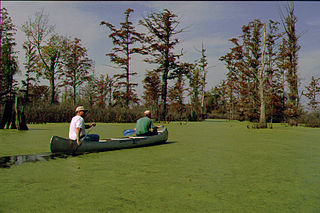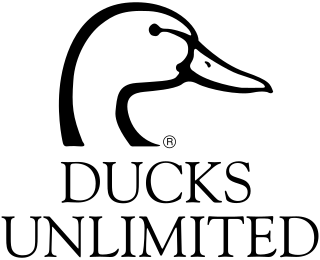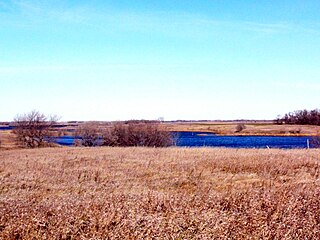Related Research Articles

The Canadian Wildlife Service or CWS, is a Branch of the Department of Environment and Climate Change Canada, a department of the Government of Canada. November 1, 2012 marked the 65th anniversary of the founding of Service.

Eastern Canada is generally considered to be the region of Canada south of Hudson Bay/Hudson Strait and east of Manitoba, consisting of the following provinces : Newfoundland and Labrador, Nova Scotia, Prince Edward Island, New Brunswick, Quebec and Ontario.

The Cache River is a 92-mile-long (148 km) waterway in southernmost Illinois, in a region sometimes called Little Egypt. The basin spans 737 square miles (1,910 km2) and six counties: Alexander, Johnson, Massac, Pope, Pulaski, and Union. Located at the convergence of four major physiographic regions, the river is part of the largest complex of wetlands in Illinois. The Cache River Wetlands is America's northernmost cypress/tupelo swamp and harbors 91 percent of the state's high quality swamp and wetland communities. It provides habitat for more than 100 threatened and endangered species in Illinois. In 1996, the Cache was designated a Wetland of International Importance under the Ramsar Convention.

Ducks Unlimited (DU) is an American 501(c)(3) nonprofit organization dedicated to the conservation of wetlands and associated upland habitats for waterfowl, other wildlife, and people.

Waterfowl hunting is the practice of hunting aquatic birds such as ducks, geese and other waterfowls or shorebirds for sport and meat. Waterfowl are hunted in crop fields where they feed, or in areas with bodies of water such as rivers, lakes, ponds, wetlands, sloughs, or coasts. There are around 3 million waterfowl hunters in the United States alone.

The Chase Lake Prairie Project is considered the "National Flagship Project" of the North American Waterfowl Management Plan (NAWMP). The goal is to rehabilitate 5,500,000 acres (2,200,000 ha) of wetland around Chase Lake on the Missouri Coteau. The project was dedicated in September 1989.

The following outline is provided as an overview of and topical guide to Canada:
The North American Waterfowl Management Plan (NAWMP) is an international plan to conserve waterfowl and migratory birds in North America. It was established in 1986 by Canada and the United States, and expanded to include Mexico in 1994.
The Prairie Habitat Joint Venture is a partnership between governments, organizations, and conservation groups in the provinces of Manitoba, Saskatchewan, and Alberta in Canada. It is one of four Canadian habitat joint ventures operating as part of the North American Waterfowl Management Plan, and is contiguous with the Prairie Pothole Joint Venture in the United States.
The North American Wetlands Conservation Act signed into law by President George H. W. Bush on December 13, 1989 authorizes a wetlands habitat program, administered by the United States Fish and Wildlife Service, which provides grants to protect and manage wetland habitats for migratory birds and other wetland wildlife in the United States, Mexico, and Canada. A nine-member council meets periodically to decide which projects to fund.
The Louisiana Department of Wildlife and Fisheries (LDWF) is a state agency of Louisiana that maintains state wildlife and fishery areas. The agency is headquartered in the capital city of Baton Rouge.
The Canadian Intermountain Joint Venture (CIJV) is a partnership of "government agencies, Aboriginal groups, nongovernmental organizations, industry, universities and landowners" for the implementation of the North American Waterfowl Management Plan in the inter-mountain areas of south and central British Columbia in Canada, and the south-western mountain region of Alberta. Its region of operation includes "all the mountain national parks", with boundaries delineated by the border with the United States to the south, the eastern crest of the Rocky Mountains to the east, the crest of the Coast Mountains to the west, and the boreal forest to the north. It is adjacent to the Intermountain West Joint Venture to the south, the Pacific Coast Joint Venture to the west, and the Prairie Habitat Joint Venture to the east.
The Pacific Birds Habitat Joint Venture (PBHJV), previously Pacific Coast Joint Venture is a partnership established in 1991 between governments, organizations, and conservation groups along the Pacific Coast of the United States and Canada, established to protect and enhance wetlands important to migratory birds, within the framework of the North American Waterfowl Management Plan (NAWMP). Participants include the provincial government of British Columbia in Canada, and the state governments of Alaska, California, Hawaii, Oregon and Washington in the United States. The venture's scope covers an area from San Francisco Bay to Alaska, west of the Coast Mountains, and it was the first joint venture of the NAWMP to have an international scope.
The Arctic Goose Joint Venture (AGJV) is a conservation partnership established in 1989 between governments, organizations, and conservation groups to coordinate research and monitoring of Arctic, sub-Arctic and boreal nesting goose populations of North America, specifically the cackling goose, Canada goose, emperor goose, greater white-fronted goose, Ross's goose, and snow goose. Executing Arctic research expeditions in collaboration with partners is a primary goal of the venture, so that the logistics of such research can be coordinated efficiently. One of its main activities is to collar geese in Canada, the United States, and other nearby Arctic areas, such as Wrangel Island of Russia.
The Intermountain West Joint Venture (IWJV) is a partnership of government agencies, nongovernmental organizations, and other public and private landowners for the conservation of bird habitats in the inter-mountain areas of the western United States. It was established in 1994 and focuses on the "implementation of the conservation goals and objectives of five major bird initiatives": North American Waterfowl Management Plan, Partners in Flight, United States Shorebird Conservation Plan, North American Waterbird Conservation Plan and the National Sage Grouse Conservation Planning Framework. Its primary objective is to address conservation issues for about 40 waterbird species which use the marshes, playas, riparian zones, lakes and other wetlands throughout its extent.
The Sea Duck Joint Venture (SDJV) is a conservation partnership established in 1998 whose mission is "promoting the conservation of North America’s Sea Ducks". The partners are the Canadian Wildlife Service, the United States Fish and Wildlife Service, the United States Geological Survey, Ducks Unlimited, Bird Studies Canada, the Pacific Flyway Council, and the council for U.S. Flyways. It is one of three species joint ventures operating within the North American Waterfowl Management Plan.

Over the past 200 years, the United States has lost more than 50% of its wetlands. And even with the current focus on wetland conservation, the US is losing about 60,000 acres (240 km2) of wetlands per year. However, from 1998 to 2004 the United States managed a net gain of 191,750 acres (776.0 km2) of wetlands . The past several decades have seen an increasing number of laws and regulations regarding wetlands, their surroundings, and their inhabitants, creating protections through several different outlets. Some of the most important have been and are the Migratory Bird Act, Swampbuster, and the Clean Water Act.

The Black Duck Joint Venture is a conservation partnership established in 1989 to stabilize and restore the population of the American black duck. It consists of government and non-governmental agencies and organizations in Canada and the United States. Its geographical scope is the Canadian provinces of Ontario, Quebec, New Brunswick, Nova Scotia, Prince Edward Island, and Newfoundland and Labrador, and the 23 U.S. states in the Atlantic and Mississippi Flyways. It was the first of the three species joint ventures operating within the North American Waterfowl Management Plan to be established.

Ducks Unlimited Canada (DUC) is a Canadian non-profit environmental organization that works to conserve, create, restore and manage Canadian wetlands and associated uplands in order to provide healthy ecosystems that support North American waterfowl, other wildlife and people. They work with industry leaders, government agencies, landowners and other non-profit organizations to collaboratively protect critical habitats. DUC is a separate organization from Ducks Unlimited Inc. (DU) and Ducks Unlimited de Mexico (DUMAC). However, the three organizations collaborate on conservation projects that benefit the wide variety of species that migrate across the continent during their annual biological cycle.

Canadian wetlands account for approximately one quarter of the world's total wetlands and is ranked with the highest surface area of wetlands on the Ramsar Conventions List of Wetlands of International Importance. Canada holds 37 designated areas of International Importance which equates to approximately 13,086,767 hectares of land.
References
- "Eastern Habitat Joint Venture: Where have all the waterfowl gone?". Government of Newfoundland and Labrador, Department of Environment and Conservation. Archived from the original on 2007-04-15. Retrieved 2008-06-08.
- "Eastern Habitat Joint Venture". Environment Canada. Archived from the original on 2007-02-20. Retrieved 2008-06-08.
- "Eastern Habitat Joint Venture in Ontario". Environment Canada. Archived from the original on 2008-05-13. Retrieved 2008-06-08.
- "Eastern Habitat Joint Venture in Ontario". Environment Canada. Retrieved 2010-12-13.
- "Eastern Habitat Joint Venture in Québec Region Origins". Environment Canada. Retrieved 2010-12-13.
- "North American Waterfowl Management Plan (NAWMP): Status Report 1997-1998". Environment Canada. Archived from the original on 2008-05-29. Retrieved 2008-06-08.
- "PEI Small Marsh Program (Eastern Habitat Joint Venture)". Government of Prince Edward Island. Retrieved 2008-06-08.
- "North American Waterfowl Management Plan (NAWMP) Eastern Habitat Joint Venture (EHJV) in Québec". WetKit. Retrieved 2008-06-08.
- "Prince Edward Island Eastern Habitat Joint Venture Wetland Stewardship Program". Wildlife Habitat Canada. Archived from the original on December 3, 2008. Retrieved 2008-06-08.